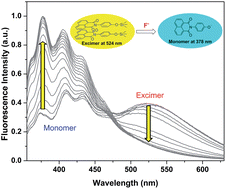Excimer–monomer switch: a reaction-based approach for selective detection of fluoride†
Abstract
A N-aryl-1,8-naphthalimide based sensor (ES-1) bearing a trimethylsilyl ether has been synthesized by a two-step reaction for quantitative detection of fluoride (F−). ES-1 exhibited monomer/excimer emissions at 410 and 524 nm respectively in CH2Cl2. In the presence of F−, the desilylation of trimethylsilyl ether caused decay of the excimer emission as well as enhancement of the monomer emission to give a ratiometric signal. The fluoride-triggered desilylation showed a high reaction rate and high affinity to F− over nine other interfering anions. ES-1 provided a novel fluorescence assay based on excimer–monomer switch of N-aryl-1,8-naphthalimide to quantitatively measure F− with a detection limit of 0.133 ppm.


 Please wait while we load your content...
Please wait while we load your content...